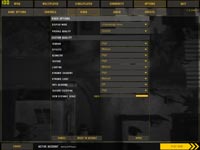Battlefield 2
Publisher: Electronic ArtsWe are using the follow up to Battlefield 1942 and Battlefield: Vietnam, Battlefield 2. It features an all-new game engine based on the DirectX 9.0 API. There is no Shader Model 3.0 support, but the majority of hardware will use a Shader Model 2.0++ mode that includes support for Normal Maps, Parallax Mapping, Full-Resolution Dynamic Shadowing, Post Processing and Fog.
The game will look the same on both NVIDIA and ATI hardware, so there is no advantage of choosing one over the other in image quality related circumstances. The only major difference is that Ultra Shadow 2 is utilised on NVIDIA's hardware, while the Shadowing on ATI hardware is done using a slightly different technique.
We played five five-minute segments of the same map, taking the median frame rate as our published frame rates. We found that there was no 100% repeatable way to benchmark this game manually, so we felt that taking a typical slice of action from the game was the best way to report our findings. We controlled Anti-Aliasing from inside the game, while Anisotropic Filtering was set to 8xAF when the 'Texture Filtering' option was set to 'High'.
Below is a table of the best-playable settings that we found best for each video card configuration. In this title, we found that 25 to 30 frames per second minimum and a target of 55 frames per second (or higher) for the average frame rate delivered a smooth and fluid gaming experience.

We had some slight problems in attaining a smooth frame rate on the Club-3D Radeon X800 XL 256MB. This was not related to the average frame rate, because that was fine at over 70 frames per second. We had problems gaining a respectable minimum frame rate with Catalyst 5.7, and you would probably be better suited to sticking with Catalyst 5.6 if you have a 256MB Radeon X800 XL already.
The XFX GeForce 6800 GT performed remarkably close to the GECUBE Radeon X800 XL 512MB SilenCool Edition, with the only difference being the fact that the GECUBE video card delivered a smooth gaming experience with Dynamic Shadows enabled - something that couldn't be enabled on the XFX 6800 GT without hampering the smoothness of game play.

MSI MPG Velox 100R Chassis Review
October 14 2021 | 15:04







Want to comment? Please log in.